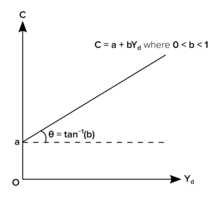Consumption function
In economics, the consumption function describes a relationship between consumption and disposable income.[1][2] The concept is believed to have been introduced into macroeconomics by John Maynard Keynes in 1936, who used it to develop the notion of a government spending multiplier.[3]

Details
Its simplest form is the linear consumption function used frequently in simple Keynesian models:[4]
where is the autonomous consumption that is independent of disposable income; in other words, consumption when income is zero. The term is the induced consumption that is influenced by the economy's income level. It is generally assumed that there is no correlation or dependence between and C.
The parameter is known as the marginal propensity to consume, i.e. the increase in consumption due to an incremental increase in disposable income, since . Geometrically, is the slope of the consumption function. One of the key assumptions of Keynesian economics is that this parameter is positive but smaller than one, i.e. .[5]
Keynes also took note of the tendency for the marginal propensity to consume to decrease as income increases, i.e. .[6] If this assumption is to be used, it would result in a nonlinear consumption function with a diminishing slope. Further theories on the shape of the consumption function include James Duesenberry's (1949) relative consumption expenditure,[7] Franco Modigliani and Richard Brumberg's (1954) life-cycle hypothesis, and Milton Friedman's (1957) permanent income hypothesis.[8]
Some new theoretical works following Duesenberry's and based in behavioral economics suggest that a number of behavioural principles can be taken as microeconomic foundations for a behaviorally-based aggregate consumption function.[9]
See also
Notes
- Algebraically, this means where is a function that maps levels of disposable income —income after government intervention, such as taxes or transfer payments—into levels of consumption .
- Lindauer, John (1976). Macroeconomics (Third ed.). New York: John Wiley & Sons. pp. 40–43. ISBN 0-471-53572-9.
- Hall, Robert E.; Taylor, John B. (1986). "Consumption and Income". Macroeconomics: Theory, Performance, and Policy. New York: W. W. Norton. pp. 63–67. ISBN 0-393-95398-X.
- Colander, David (1986). Macroeconomics: Theory and Policy. Glenview: Scott, Foresman and Co. pp. 94–97. ISBN 0-673-16648-1.
- Keynes, John M. (1936). The General Theory of Employment, Interest and Money. New York: Harcourt Brace Jovanovich. p. 96.
The fundamental psychological law ... is that men [and women] are disposed, as a rule and on average, to increase their consumption as their income increases, but not as much as the increase in their income.
- Keynes, John M. (1936). The General Theory of Employment, Interest and Money. New York: Harcourt Brace Jovanovich.
The marginal propensity to consume is not constant for all levels of employment, and it is probable that there will be, as a rule, a tendency for it to diminish as employment increases; when real income increases, that is to say, the community will wish to consume a gradually diminishing proportion of it.
- Duesenberry, J. S. (1949). Income, Saving and the Theory of Consumer Behavior.
- Friedman, M. (1957). A Theory of the Consumption Function.
- d’Orlando, F.; Sanfilippo, E. (2010). "Behavioral foundations for the Keynesian consumption function". Journal of Economic Psychology. 31 (6): 1035. doi:10.1016/j.joep.2010.09.004.
Further reading
- Poindexter, J. Carl (1976). "The Consumption Function". Macroeconomics. Hinsdale: Dryden Press. pp. 113–141. ISBN 0-03-089419-0. (Undergraduate level discussion of the subject.)
- Sargent, Thomas J. (1979). "The Consumption Function". Macroeconomic Theory. New York: Academic Press. pp. 298–323. ISBN 0-12-619750-4. (Graduate level discussion of the subject.)